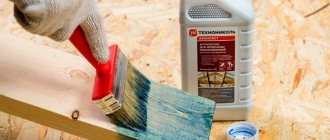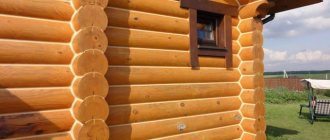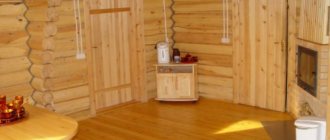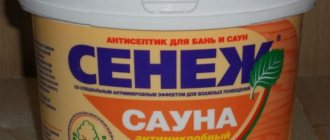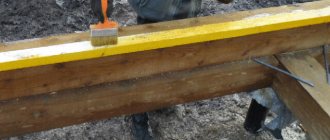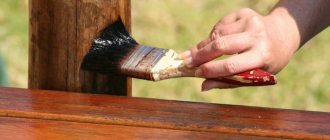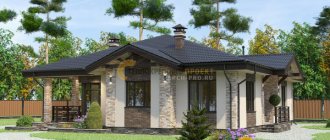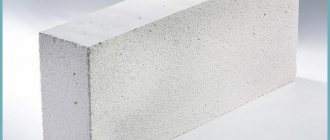Water-repellent impregnation for wood
Hello dear readers and regular blog subscribers! Today we will “protect wood” from moisture...
Wood is without a doubt the most popular and widely used building material. We use it to build bathhouses, houses, make furniture and other various household utensils. Wood attracts with its aesthetics, environmental friendliness, elegance and ease of processing.
Recently, water-repellent impregnation for wood has become an integral attribute of any construction site. And this is truly the right decision. We will try to consider why this happens in this article below...
Kinds
Water-repellent impregnations are also called gyrophobic agents. In their pure form they are rarely found. Depending on additional properties, they come in several types.
Fire retardant
Such products resist not only moisture, but also fire, and reduce the flammability of building and finishing materials. They contain fire retardants. Then the flame in case of fire spreads much slower.
Impregnations with fire retardants do not make the material non-flammable, but only prolong the combustion time.
With priming properties
Such impregnations can also be used as a primer. They not only protect the material from moisture penetration, but also improve adhesion to the finishing coating and reduce the consumption of the latter.
From rot and mold
The peculiarity of these products is their maximum ability to drive away moisture. They also include fungicidal drugs that suppress the growth of mold.
Color impregnations
These products contain pigmentation. They tint the wood and make it more decorative, emphasizing the structure.
Expert opinion
Levin Dmitry Konstantinovich
If the timber or board has a light blue or gray-green tint when purchased, then it has already been treated with moisture impregnations. But just in case, you need to clarify this point with the seller and ask to show certificates for the products.
Why does wood need antiseptic treatment?
What is antiseptic? This is the impregnation of wood with various chemicals that preserve it from the inside. But why should such a convenient building material be “preserved”? Now we will try to explain.
Interesting fact: wood is similar in structure to reinforced concrete structures. It also consists of “rebar” and “concrete” - two main compounds, cellulose and lignin. Cellulose is a polymer with a linear structure, but lignin has a developed multidimensional structure. Lignin, like concrete, has high compressive strength, while cellulose provides wood with flexibility.
That's why, when building a house out of wood, it is important to remember that you are working with living material, and all living materials obey the laws of nature. In the process of its development, a tree forms organic compounds from inorganic compounds, and after the end of its life, the tissues begin to be processed by saprophytes, popularly called fungi
Fungi feed on dead wood fibers and convert them back into minerals. At the same time, mushrooms secrete special enzymes and grow mycelium using spores, which requires a certain temperature, oxygen, nutrients and water.
Moreover, these fungi are divided into two main groups - wood-coloring and wood-destroying.
The former develop only on wood of natural moisture and along the way give it a shade of blue, red, yellow or green, remaining mainly in the sapwood and only occasionally penetrating into the core. They die when heated above 80°C, and during their lifetime they do not have a significant effect on the strength of wood, because they are unable to destroy lignin. Therefore, the very presence of an unattractive shade of wood is rather a sign of a violation of the transportation and storage of lumber.
But the presence of wood-staining fungi in wood often indicates the risk that the same material is also infected with wood destroyers of the same kind. Also remember that wood-staining mushrooms often mask rot with their color. But wood-destroying fungi are capable of destroying wood completely, transforming it into dust and humus, and this is a natural process, as you remember.
That is why, even during the production of building material for the home, it is subjected to conditions unfavorable for the development of fungi: harsh drying, high temperature, and the use of carefully selected chemicals.
Here we are talking about antiseptics:
Base type
Impregnations are also distinguished by the type of base. They are:
. These products are inexpensive and have good water-repellent properties. Their advantage is environmental friendliness. The compositions dry quickly and do not emit an unpleasant odor. Such impregnations are recommended for slightly damp wood, into which solvent-based products will not penetrate. One of the disadvantages is the inability to process wood at subzero temperatures. Acrylic impregnations are not recommended for old, dry wood. Under the influence of such compounds, the material may swell and crack.
Water based (acrylic)- Organic based . This type of water repellent is more often used outside buildings. They reliably protect the tree from the negative influence of the environment, penetrate inside faster and deeper. Their disadvantage is toxicity, which persists until the liquid dries completely. Therefore, it is better to use organic impregnations outdoors. If they are intended for interior work, then be sure to ventilate the room well and use personal protective equipment during processing. Organic water repellents are used for both planed and unplaned logs.
- On a combined basis . These products have the advantages of both products at once, since they contain both an organic and a water-dispersed component. The first provides deep, the second - superficial protection.
Prevention
The main provocateur of putrefactive processes in wood is moisture. Therefore, first of all, it is necessary to ensure proper storage conditions. Ventilation and waterproofing are provided in the room.
When storing timber on the street, sheds are organized. The material must be folded so that the surfaces of the boards are well ventilated. Drying is carried out periodically under natural conditions.
To reduce the moisture content of wood, it is not recommended to use hair dryers and other thermal installations. A sharp change in temperature provokes deformation of the wood.
The boards are laid in such a way that at least 10 cm remains from the ground surface to the flooring. A drainage layer is first laid under the storage so that water does not stagnate after prolonged rainfall.
For long-term storage of wood, choose one of the suitable options:
- Drying in a special chamber (moisture evaporates under the influence of a hot air stream).
- Paraffinization (immersion of material in liquid paraffin followed by exposure in an oven).
- Steaming in linseed oil (boiling wood in oil for several minutes).
When creating conditions for storing wood blanks, predisposing factors for rotting should be taken into account:
- increased air humidity (80-100%);
- increased material humidity (more than 15%);
- temperature from +2 to +40 degrees.
FAQ
What is the best way to coat wood to preserve its natural color?
To preserve the natural pattern and color, the wood is varnished. This task is best accomplished with water-dispersion acrylic-based varnish without pigment, oil impregnations. Other types of coatings turn yellow over time.
How to choose
It is preliminarily determined where it is planned to apply the impregnation - inside or outside the building. Facade products may contain ingredients that are harmful to health, but are indispensable for more reliable protection of wood from the influence of climatic conditions. For products used outside the building, frost resistance and ultraviolet filters will also be required.
Pay attention to whether the shade has a protective coating. If they then want to cover the wood with transparent products - for example, varnish, oil, wax, then the final shade will be completely different from what was intended in the project.
They analyze what additional properties are still needed - protection from pests, fire, surface texture, etc.
Environmental friendliness and harmlessness to health are also important, especially when it comes to the treatment of walls or decoration in a children's room, bedroom, or kitchen. It should also be taken into account that not all water repellents for walls and ceilings can be used on the floor.
Often buyers choose products based on price, but do not pay attention to consumption. Thus, cheap compounds are sometimes recommended to be applied in 3–4 layers. When using products of a higher price segment, you can often get by with double processing.
Final Recommendation
By the way, last year, an old friend of mine bought impregnations for his new home from a dealer. The first thing he liked was communicating with the consultant. According to a friend, he understands very well when it comes to choosing impregnating agents for wooden structures. And second: the price of the product turned out to be quite acceptable, which is important for many buyers.
This is not an advertisement - just a consultation, which is always useful. For residents of Moscow and the Moscow region, I recommend this company for the sale of Neomid impregnations. Moreover, the company is specialized, sells retail at wholesale prices and has been on the market of high-quality wood protection products for several years.
That's all for now. I hope this was informative? If yes, then recommend the article to your friends and subscribe to the news. I wish you all good luck, health and peaceful skies. Bye!
Wisdom Quote: What is not true cannot be great.
The best products on the Russian market
These water repellents are very popular among professionals and home craftsmen.
V33 Extreme Climate
Water-based impregnation for extreme wood protection has a 12-year guarantee. The product imparts moisture-repellent properties to wax. The drug forms a microfilm that allows the wood to breathe.
Anti-corrosion components protect metal parts from corrosion. The line is available in 12 colors. The product also contains UV filters. Extreme Climate can be used inside and outside buildings.
In earlier versions, the product was called azure, impregnation, the new name is antiseptic.
Flugger Wood Tex Transparent
Glazing impregnation based on alkyd oil and acrylic resins dispersed in water creates a semi-matte protective film on the surface. The texture is thick, jelly-like, easy to apply. The product is designed for exterior work. If application technology is followed and two-layer coating is used, the service life of the coating reaches 10 years. Complete rejection occurs within 48 hours.
Goodhim TEXTURE 651 BASE A
The basis of the covering antiseptic is acrylic dispersion. The composition also includes biocides, fungicides, oils, and wax emulsion. The product is used on unpainted, painted, darkened wood materials, as well as for painting in light colors. The water repellent is not suitable for floor treatment. The drug is available in two variations: A - white, C - transparent.
Dufa Wood Protect
The product protects the wooden surface not only from moisture, but also from dirt.
The impregnation is made using new technology. The alkyd component promotes deep protection of materials from the inside, and the acrylate dispersion forms a film. The product is intended for walls and ceilings only, and should not be used on floors or other surfaces subject to mechanical or chemical stress. Dufa Wood Protect is also suitable for exotic wood species.
The product has a viscous, jelly-like (thixotropic) structure and does not form drops when applied. The texture of the coating is matte. The collection includes 8 shade options - from white and colorless to rosewood.
Pinotex Ultra Lasur marigold
The composition forms a moisture-repellent layer that does not hide the wood texture. The manufacturer included a UV filter and components that prevent the growth of algae and mold. Protective properties are provided by alkyd resin and linseed oil. The coating layer resembles varnish and gives the painted surface water- and dirt-repellent properties. The product is recommended for outdoor use.
Tikkurila Eko Wood
A glazing antiseptic based on an organic solvent helps protect the wood outside the building. The product penetrates deeply into the wood and slows down the decomposition of fibers caused by exposure to moisture. Tinted compounds also ensure that the material is resistant to ultraviolet radiation.
What is wood impregnation used for?
When faced with a processing question, the first thing a consumer thinks about is the purpose of the activity.
It should be understood that wood is an organic material that tends to wear out and be exposed to various harmful factors.
Considering in detail these factors can be divided into:
- Humidity.
- Sudden temperature changes.
- The presence of beetles and fungal formations.
- Harmful effects of open fires.
To prevent wear and destruction, preparatory measures are carried out, among which the main place is occupied by wood impregnation.
You can give a list of the main phenomena from which such treatment will protect:
- Changes in material colors, fading.
- The presence of insects that feed on woody elements.
- Darkening due to dust and dirt exposure.
- Soaking and rotting.
- The formation of cracks, which is caused by temperature changes, as well as from frequent precipitation.
- Destruction of wood due to exposure to ultraviolet radiation (sun rays).
Considering such a list, we can say that the range of protective properties of impregnation is quite large, but this is not a complete list of all functions, since there are many types of this treatment and each of them has its own properties and functions.
How to use
The wood is first cleaned and the resinous areas are scraped off. Remove mold using a scraper or wire brush. Then impregnation is applied - at least 2 layers.
Impregnations are applied in several ways:
- immerse the wood in the solution;
- use a brush or roller;
- applied with a spray.
The use of a sprayer increases the consumption of the product. Organic-based water repellents are not recommended to be applied by spray due to their toxicity.
New items at Kant:
- Temporary changes to store opening hours
- Cross-country ski equipment for athletes. Full set. Everything is ready for the 21/22 season
- New “winter” collections. Hurry before temporary closure
- Updated Thermos collection
- It's warmer with the Arctic
- Bobber thermoses. Record heat retention
- 10% discount on winter goods for Second Hand customers
- Seasonal bicycle storage with maintenance
- A clear victory for Deuter in independent research. Backpacks and sleeping bags are the best!
- Collection "Autumn 2021" from Petzl in "Kant". Flashlights and climbing equipment
- The best autumn adventures - with Salomon clothing
- Mizuno super-collection “Winter 21-22” is available in “Kant”
- The new Saucony collection “Winter 21-22” is in “Kant”... and Endorphin_2 too”!
- Running “rockets” from adidas exclusively in Kant!
- Everything for cross-country skiing 2021 -2022 already in Kant!
- There is no bad weather! The right Reima clothes for a child in the off-season
- New collection of KV+ ski poles
- Custom anatomical insoles in 15 minutes
Making your own product
This ancient recipe has been used for centuries. You can cook it yourself from available products. The impregnation is environmentally friendly, emphasizes the wood texture well, and protects against moisture due to the content of vegetable fats and wax.
What water-repellent impregnation would you use?
PurchasedHomemade
To prepare the product you will need the following ingredients:
- linseed oil - 0.5 l;
- beeswax - 50 g;
- a slice of pine rosin the size of a quail egg.
Step-by-step instructions for preparing the impregnation:
- Oil is poured into a pan that is no longer used for cooking.
- Grind the wax using a grater or a knife.
- Place the pan on the stove, add wax, and add rosin.
- Turn on minimal heat.
- Boil the oil solution, stirring constantly until the wax is almost completely dissolved.
- Turn off the fire.
Homemade water repellent is ready.
As a rule, home remedies are less effective than factory-made drugs. And the final cost of the “grandfather’s funds” may turn out to be higher. It’s a personal matter for everyone which option of water repellent to choose. But even the simplest impregnation will in any case extend the life of a wooden house and finishing made from this material.
Beeswax
Very often, linseed oil with the addition of beeswax is used to treat wood.
Properties:
- Safe for health.
- Thanks to wax, the surface acquires water-repellent and scratch-resistant properties.
- The waxing procedure makes the wood shade more expressive and gives it a dark, noble, slightly golden hue.
- The texture of the wood appears more clearly.
- Wax-treated material continues to “breathe”, unlike varnish coatings
- Very pleasant smell.
- Wax in combination with linseed oil has even higher water resistance properties.
- Can be used on any wooden surface: houses, floors, doors, furniture and even toys.
Conclusion
To preserve the presentable appearance of the facade or decoration and prevent harmful effects, specialized protective equipment is used. They will not only emphasize the beauty of the tree, but will also help extend its service life, and timely renewal of coatings will postpone the need for replacement or reconstruction for many years.
Not only the original wooden walls need protection, but also any wood facing materials, for example, imitation timber or shingles. In the video there is a master class: a wooden sofa for the garden.
Subscribe to our Telegram channelExclusive posts every week
Processing rules
Processing boards with impregnation does not cause any particular difficulties. However, there are several rules that must be strictly followed to achieve the desired result and maintain your own health:
- It is imperative to protect all vulnerable areas of the human body that will be in direct contact with the solution (hands: eyes, respiratory organs).
- Before processing wood to prevent it from rotting, it is necessary to prepare it for work: clean it of dust, grease or previously applied paint.
- The board is carefully processed using a brush with metal bristles.
- It is best to wash the surface using detergents.
- It is equally important to let the wood dry thoroughly.
- Before impregnating the wood, carefully read the instructions for its use on the packaging.
- It is recommended to start with the end parts of the board, cuts and areas that are already damaged.
- If there is a need to apply the product in several layers, it is necessary to allow time for the previous layer to dry completely. Typically this period of time is 2–3 hours.

